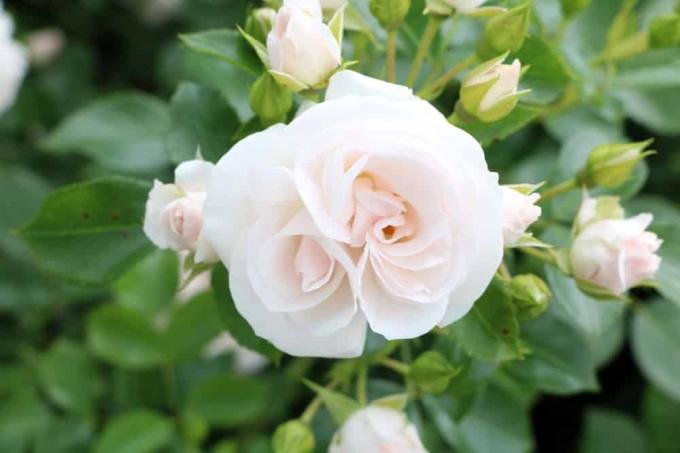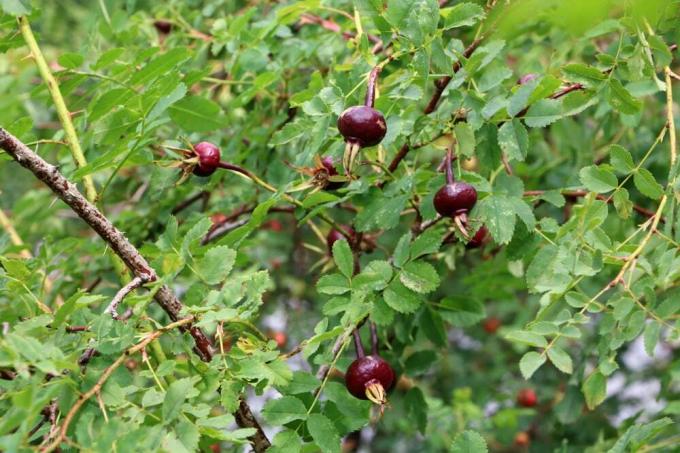

Table of contents
- harvest seeds
- preparatory work
- break germination inhibition
- stratification
- sowing
- pinch
- plant out
- Conclusion
Propagating magnificent roses from seed is undoubtedly considered the ultimate challenge within the gardeners' guild. With a long thread of patience, plenty of instinct and these instructions for rose propagation, the plan can definitely succeed. The rose hips of a wild rose provide the seeds for a single-variety offspring. Anyone who likes to be surprised by the result can use the fruit of their most beautiful noble rose. It's worth a try anyway, because the first rose you grow yourself is the crowning glory of any hobby gardener's career.
harvest seeds
In order for a rose to develop its bright red or orange hips, the flowers must remain on the bush until they have completely withered. Rose hips are aggregate nuts containing between 10 and 30 small nuts that serve as seeds. If the mother plant is a wild variety, the later young plants take on exactly their attributes, so that botanists speak of a varietal propagation. The outcome of sowing seeds of a rose variety, on the other hand, is a gardening roulette. No one can predict which traits of the parent or grandparent plants will prevail. At this point, the great fascination of rose breeding is revealed, because this is how many a legendary rose queen saw the light of day. How to proceed with the seed harvest:
- Harvest the rose hips when they are completely colored
- Dried and wrinkled fruits are unsuitable for sowing
Since the germination rate of rose seeds is very low, as many rosehips as possible are harvested. In this case, a larger mass increases the subsequent yield.
Tip:
The germination test with floating seeds does not work on roses. Even germinable nuts often swim on the water surface.
preparatory work
After the seed harvest, the next work steps are tackled without further delay. In particular, the fruit should not be dried because the seeds inside become unusable. The fresher the seed, the better the chances of success. The preparation goes as follows:
- Cut the rose hips into pieces with a sharp knife
- Scoop out the seeds inside with the tip of a knife or a spoon
- Place in a colander and wash off the pulp under running water
It is essential to completely clean the seeds from the pulp. There is nothing wrong with rubbing your fingers over the sieve bottom under the water jet. The cleaned seed then immediately enters the next phase.
break germination inhibition
In the plant world, seeds that thrive within a fruit are naturally retardant. In this respect, rose seeds are no exception, because they have a hard shell that is sometimes more or less hairy. In this way, Mother Nature ensures that the nutlets do not germinate and die prematurely in winter. In order to overcome this inhibition threshold, the seed undergoes the following treatment after cleaning:
- Pour 2 cups of water (240 ml each) into a bowl
- Mix in 3 teaspoons of 3 percent hydrogen peroxide
- Soak the seeds in this solution for 20 minutes
- Then dilute with 2 more cups of water and leave to swell for another 24 hours

On the one hand, the pre-treatment described effectively prevents the formation of mold, while at the same time the hard seed coats are softened. Hydrogen peroxide is available in pharmacies. If you prefer a less drastic approach, soak the rose seeds in lukewarm chamomile tea for 48 hours. To do this, fill the prepared tea in a thermos flask and add the seeds. This way the temperature is maintained over the time frame.
stratification
By nature, rose seeds are not only protected from premature germination by their hard shell. In addition, a cold stimulus is required to finally put the nuts in the mood to germinate. In concrete terms, this means for rose propagation that the seeds have to be exposed to a simulated winter. Botanists refer to this process as stratification. The following instructions show how this can be achieved with simple means:
- Fill a plastic bag with damp sand or sphagnum
- Add the seeds and seal the bag tightly
- Store in the vegetable compartment of the refrigerator at 4-5 degrees Celsius
During the following 4-6 weeks, the moisture content is checked from time to time, because the seed must not dry out. Germinating seeds are immediately discarded and enter the next stage of sowing. A heated greenhouse or cold frame eliminates the need for stratification in the refrigerator. Sown in small pots at a constant temperature of 4-5 degrees Celsius, germination also begins within 1-2 months.
Tip:
The seed harvest and pre-treatment are not necessary if the roses are propagated with already stratified seeds from the specialist trade.
sowing
Plant the seeds at the first sign of germination. Multi-pot trays or small seed pots are best suited. Fill this with lean potting soil that has been disinfected in the oven for 30 minutes at 150 degrees. The substrate is moistened with water from the spray bottle before the seedlings are planted.
- Make a well in the substrate with a pencil or prick
- Insert one seedling at a time with the root shoot down
- Place in a bright, not full sun location at 20 to 25 degrees Celsius
Once the small roses have completely rooted in the nursery pot and developed 4 to 6 leaves, they are repotted in nutrient-rich, well-drained rose soil. They are kept constantly moist in the sunny, warm window seat until the planting season begins in mid-May.
pinch
The bushy growth of roses is effectively supported by early pinching. Pluck off the fresh shoots repeatedly with your index finger and thumb or tweezers. This measure elicits further side shoots from the young plant, which over time results in lush branching.
plant out
Young plants that develop vigorously are suitable for moving to the bed or onto the balcony from May. If in doubt, continue feeding weaker specimens until early autumn and then plant them out. Attention to soil fatigue also applies to plants that come from rose propagation by seed. Therefore, choose a location where no rose plants have been cultivated in previous years. A sunny, airy location is ideal
- The soil is rich in nutrients, humic and deeply permeable
- Create a planting pit for each rose with twice the volume of the root ball
- A drainage on the sole made of potsherds or grit prevents waterlogging
- Enrich the excavation with compost, horn shavings and a little sand
- Fill in a handful of substrate, insert the rose in the middle
- Surrounded with soil as far as it was in the pot before and watered
In the following months and years it remains to be seen when the first flowers will appear. Roses planted in May are fertilized for the first time in mid/end of June. At the end of July/beginning of August the flowers receive a final dose of fertilizer in the form of patent potash to prepare them for the coming winter. Generous heaping up with Lauberde soil before the first frost serves as an effective winter protection.
Conclusion
Propagating roses from seed takes a certain amount of persistence. The rose hips are to be harvested at the right time. The seed it contains is doubly protected against premature germination. It is important to soften the hard seed coat and to get the seeds ready to germinate as part of stratification. If this pre-treatment has been successfully completed, further sowing takes place according to the classic general conditions. Small roses develop quickly in the bright, warm location and can be planted out from May. Then the tension increases with what result the self-propagation of roses by seeds will be crowned.
 garden editorial
garden editorial I write about everything that interests me in my garden.
Learn more about Rose

Ground cover roses: care from A – Z
All varieties of ground cover roses are attractive plants with an abundance of flowers consisting of single or double, single or multicolored and delicately scented flowers. Sometimes they even bloom several times a year. They are a low-maintenance and pretty alternative to green ground covers.

Pruning & caring for wild roses | Instructions for Hundsrose & Co.
Wild roses are the easy-care archetype of the rose, but even they cannot do without care in the garden. With the right care, wild roses such as the dog rose or the apple rose produce lush flowers and can be used in a variety of ways in the garden.

Rare Flowers and Bulbs: 20 types of flowers
Experiencing the magic of a species-rich flower meadow is a rare privilege. Intensive agriculture and forestry leave numerous plant and animal species little chance of survival. Reason enough to plant rare flowers and flower bulbs in your own garden and save them from perishing. These 20 types of flowers are floral beauties with a rarity value.

Dune rose, burnet rose, Rosa pimpinellifolia - care instructions
The dune rose or burnet rose is a "rose for all occasions", which brings a wealth of the most beautiful flowers into the garden with the lowest demands. In the article you will learn how easy it is to take care of the versatile rose.

Take care of old roses - transplant and cut properly
Beautiful newly designed garden, only the old roses are now really in the way? Read how to properly transplant and cut old rose bushes.

Tufted rose, Rosa multiflora, Multi-flowered rose - care & pruning
Tufted rose, Rosa multiflora, multi-flowered rose - as the plant is also called, the flowers and the scent are simply attractive. In order for both to be preserved for a long time and to enrich the garden, the plant must also be cared for accordingly and trimmed regularly. With the right instructions, this is also possible for laypeople.


